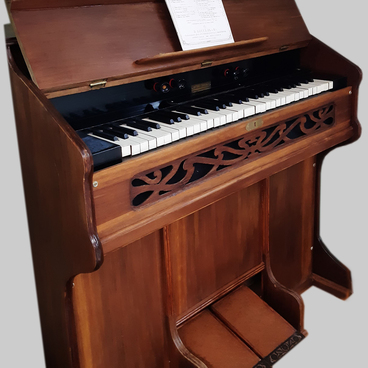The exhibition showcases a mechanical clock with a spring drive and chimes. The clock is in a wooden case, the outer side of which is decorated with turning and carving. The round clock face is covered with white enamel and Roman numerals. On the end of the brass pendulum, there is a mark of two crossed arrows on a white background with the letters R and A on both sides.
The clock is assumed to have been manufactured by the company ‘Le Roi A Paris’ (King of Paris). It was made in Germany in the 19th century. The clock belonged to the family of a worker of the Izhevsk factory. An expensive wall clock in the house symbolized well-being. Ivan Andrzheevsky, the doctor of the hospital of Izhevsk arms factory, wrote: ‘The Izhevsk gunsmith scarcely knows what is home comfort. Almost all his furniture includes: an unpainted wooden table, two-three similar chairs, benches along walls, and a cupboard in the corner. The Tula samovar becomes the first sign of developing prosperity in the house. Then follows a large cheap wall clock. As soon as a gunsmith is in need, he sells the clock and the samovar to his happier neighbor. But he buys these things again as soon as he can. If there is neither a clock, nor a samovar in his house, then things look black for the gunsmith.’
Clock is one of the most important inventions of mankind. The history of the first wall clock dates back to the UK of the 19th century. The first home clock was standing on the floor due to its large and heavy structure. The clock was so heavy that it was impossible to hang it on the wall. It was made of expensive wood. The case was decorated with bas-reliefs, carvings, and even sculptures. The tower clock is considered to be the prototype for the wall clock.
The establishment of the British workshops making Lucerne wall clock marked a new step in development of clock-making. A clock featured a heavy case made of wood, bronze, and brass, which was connected with the name. The clock mechanism featured only the hour hand until the end of the 17th century. The clock production always included engraving, ornaments, and patterns. The case and the round dial were decorated in the same style with the furniture. Austria is considered to be the birthplace of the wall clock. The first weight clock appeared in the country in the early 19th century. The fashion for clock was spreading from the UK, Germany, and France throughout Europe. The wall clock appeared in Russia under Peter the Great. Soon, the Russian craftsmen mastered this trade.
The clock is assumed to have been manufactured by the company ‘Le Roi A Paris’ (King of Paris). It was made in Germany in the 19th century. The clock belonged to the family of a worker of the Izhevsk factory. An expensive wall clock in the house symbolized well-being. Ivan Andrzheevsky, the doctor of the hospital of Izhevsk arms factory, wrote: ‘The Izhevsk gunsmith scarcely knows what is home comfort. Almost all his furniture includes: an unpainted wooden table, two-three similar chairs, benches along walls, and a cupboard in the corner. The Tula samovar becomes the first sign of developing prosperity in the house. Then follows a large cheap wall clock. As soon as a gunsmith is in need, he sells the clock and the samovar to his happier neighbor. But he buys these things again as soon as he can. If there is neither a clock, nor a samovar in his house, then things look black for the gunsmith.’
Clock is one of the most important inventions of mankind. The history of the first wall clock dates back to the UK of the 19th century. The first home clock was standing on the floor due to its large and heavy structure. The clock was so heavy that it was impossible to hang it on the wall. It was made of expensive wood. The case was decorated with bas-reliefs, carvings, and even sculptures. The tower clock is considered to be the prototype for the wall clock.
The establishment of the British workshops making Lucerne wall clock marked a new step in development of clock-making. A clock featured a heavy case made of wood, bronze, and brass, which was connected with the name. The clock mechanism featured only the hour hand until the end of the 17th century. The clock production always included engraving, ornaments, and patterns. The case and the round dial were decorated in the same style with the furniture. Austria is considered to be the birthplace of the wall clock. The first weight clock appeared in the country in the early 19th century. The fashion for clock was spreading from the UK, Germany, and France throughout Europe. The wall clock appeared in Russia under Peter the Great. Soon, the Russian craftsmen mastered this trade.



